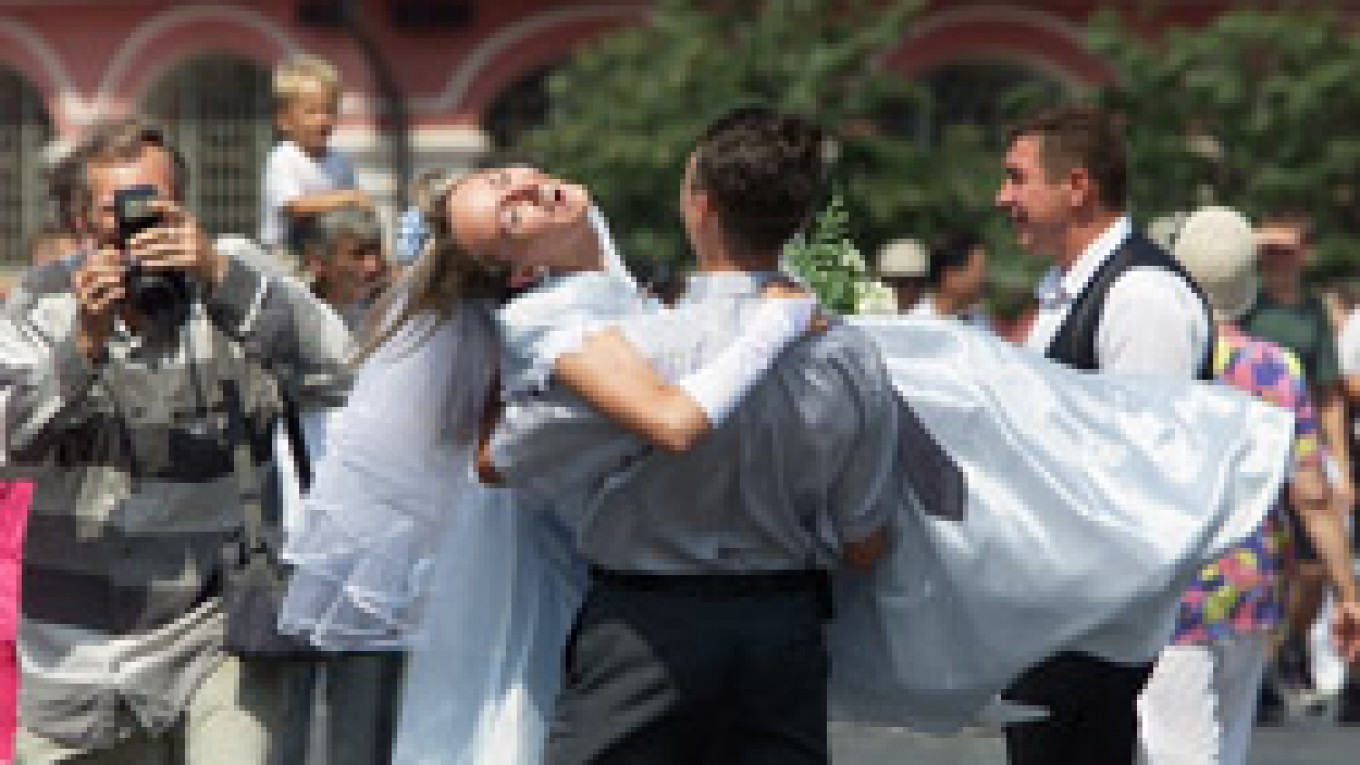In pre-Revolutionary Russia, weddings were considered the high point of one’s life. Peasants and aristocrats alike divided their lives into two parts — before and after the wedding — and village celebrations would often stagger on for a whole year after the wedding itself.
Communism tried to rid Russians of the “bourgeois” mentality and reduce marriage to the official act of stamping one’s passport at ZAGS — the abbreviation for a registry office — but failed miserably and the svadba, or wedding, remains a treasured occasion.
The exhibit “Topography of Happiness: Russian Wedding from the 19th to the 21st Century” at Tsaritsyno uses 21 walk-through rooms to tell the story of Russian wedding culture. The exhibit includes an array of wedding-related items, dresses and accessories, video recordings, photos, paintings from the Tretyakov Gallery and even fortunetelling tools that visitors can test on themselves
Each room of the show — “Happiness by Lottery,” “Wedding Feast,” “Fortunetelling of the Maidens,” “Dowry Chest,” “Wedding Blessed by God,” “Wedding Blessed by People: ZAGS” and “Photo Memories” — reflects a different aspect of the Russian wedding.
“We spent the past 15 months putting the exhibit together piece by piece. Although the majority of show items come from the St. Petersburg Wedding Museum, the Russian Ethnographic Museum and St. Petersburg’s Historical Museum, many of the wedding dresses were donated by families especially for the exhibit. Because of these gifts, we are happy to say that our show is not an ordinary display of historical items but carries elements of personal wedding memories,” said curator Olga Sosnina.
Several months before the opening, organizers announced a countrywide wedding photo contest. The selected photos of newlywed Russian couples, posing in front of their city’s most famous sites, adorn a map of Russia creating a “topography of happiness.”
The exhibit has a contemporary design by Konstantin Larin that combines classic display techniques with video installations and interactive games. One of the rooms shows an animated video of a grotesque bride riding an automobile on a human-size screen covered with a bridal veil. Another room offers a contemporary version of bridal fortunetelling: Televisions on the walls play wedding excerpts from different Russian films, but if you spin a wheel in the room fortune will choose one of them and you will see, organizers say, your own wedding fate.
“At Russian weddings, guests are never just spectators, they always participate in various games and rituals. We wanted our exhibit to reflect that interactive side of the wedding,” said Sosnina.
A highlight of the show is the collection of bridal dresses, each with its own story. A simple wedding dress from 1941 stands out with its black flower pattern. The black was a sign of mourning for war victims, said Olga Morozova, who added that the bride had to wait for 10 years after her engagement, before her fiance returned from the war, in order to get married. The wedding eventually took place in 1951.
“One of the most expensive and exquisite dresses in my collection belonged to a Russian immigrant in France,” said Morozova. “Having left Russia during the Revolution, she had always wanted to return but never could. After her death, her relatives sent me the wedding dress, which she had bequeathed to my museum.”
The last of the wedding dresses is an intricate gown from couturier Valentine Yudashkin’s 2008 collection that shows modern Russia’s take on the wedding. In stark contrast to the elegant but modest “Jackie Kennedy-style” dresses from the 1960s and 1970s, Yudashkin’s creation is in-your-face extravagance with a puffy skirt and cleavage that would have made Marie Antoinette proud.
The exhibit is not limited to the joyful side of marriage, and visitors can look at two rare decrees from the Orthodox Church’s Synod, from 1908 and 1914, ruling on the right to divorce in cases of adultery.
Visitors can seal their wedding-themed visit by having their picture taken as man and wife, as the exhibit has provided a cardboard stand of a bride and groom, drawn by a child. Just stick your heads through the two holes and smile.
The exhibit “Topography of Happiness: Russian Wedding from the 19th to the 21st Century” runs until Oct. 18 at the Khlebny Dom, Tsaritsyno Park Complex. 1 Dolskaya Ulitsa. Metro Tsaritsyno, Orekhovo. Tel 321-0743.
A Message from The Moscow Times:
Dear readers,
We are facing unprecedented challenges. Russia's Prosecutor General's Office has designated The Moscow Times as an "undesirable" organization, criminalizing our work and putting our staff at risk of prosecution. This follows our earlier unjust labeling as a "foreign agent."
These actions are direct attempts to silence independent journalism in Russia. The authorities claim our work "discredits the decisions of the Russian leadership." We see things differently: we strive to provide accurate, unbiased reporting on Russia.
We, the journalists of The Moscow Times, refuse to be silenced. But to continue our work, we need your help.
Your support, no matter how small, makes a world of difference. If you can, please support us monthly starting from just $2. It's quick to set up, and every contribution makes a significant impact.
By supporting The Moscow Times, you're defending open, independent journalism in the face of repression. Thank you for standing with us.
Remind me later.


